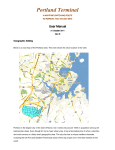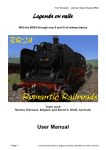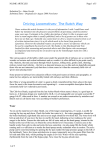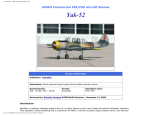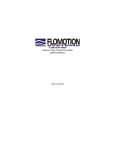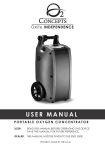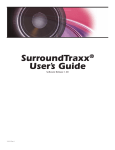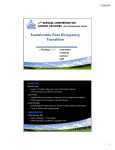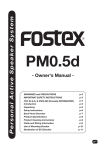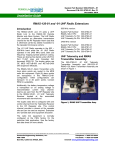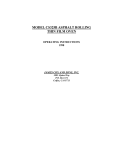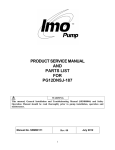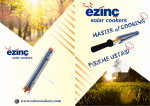Download Southern Pacific Cab Forward User Manual
Transcript
Southern Pacific Cab Forward
User Manual
1 Background
1.1 Heritage
It was the early 20th century and business in California was booming. On Southern Pacific's Sacramento
Division, the Donner Pass route, shipments of agricultural products and manufactured goods bound for the
populous East were on the increase. Trains were getting longer and heavier and the railroad needed more
power to handle the rising demand. Accordingly, SP ordered several conventional Mallet 2-8-8-2 articulated
locomotives and began to take delivery of them in 1908.
The Mallet locomotives provided the needed power, but they proved to be unworkable due to the many
tunnels and snow sheds along the route. Stack gases, discharged from the front of the boiler and
concentrated within these structures, placed the crews at risk of asphyxiation. It didn't take long for
engineers to begin running the locomotives backwards.
Of course that created other problems, so SP engineering came up with a new arrangement with the boiler
turned around to alleviate the smoke issue, but with the tender running behind and the cab interior facing
forward. Because the firebox on these "backwards" boilers was located in front, the new locomotives were
designed to burn fuel oil. Oil was supplied from the tender under slight pressure in piping that ran the entire
length of the locomotive.
As the design evolved, the Mallet concept of using exhaust steam from the first set of cylinders to power
the second set was abandoned. Instead, both sets of cylinders were supplied with live steam and the first
Articulated Consolidation (AC) class locomotives made their appearance in 1911. Subsequent improvements
culminated with the AC-10, AC-11 and AC-12 classes represented in this release for RailWorks. The three
classes, which were the last to be built, are essentially identical except for the road numbers, as indicate in
the following:
AC-10:
AC-11:
AC-12:
4205—4244
4245—4274
4275—4294
The Cab Forwards were unique among all US locomotives. They had several distinguishing features including
"stack splitters" used to prevent damage to the roofs of wooden snow sheds, drifting valves mounted atop
the cylinders, long rectangular blowdown spreaders, and large "Southern Pacific" lettering on the tender.
Beginning in 1946, the lower front portion of each cab was repainted in the emblematic silver color scheme.
Both of the Westinghouse cross-compound air compressors were mounted on the smokebox along with
components of the Worthington feedwater heating and pumping system. The Cab Forwards were the only
US locomotives in which the compressor steam exhaust was released directly to the atmosphere, emitting
an instantly recognizable "wheeze" sound. The compressors and other equipment were accessed from the
"monkey deck" situated between the smokebox and the tender.
Eventually, Cab Forward locomotives were in common use on most of Southern Pacific’s routes in California
and into Nevada and Oregon. However, as the dieselization trend gained momentum in the 1950s, the Cab
Forwards were gradually removed from service. The last run of a Cab Forward over Donner Pass, by AC-11
number 4274, took place in 1957 and its journey is documented in a well known film/video.
1.2 Specifications, AC-10/11/12
Builder
Whyte Notation
Boiler Pressure
Tractive Effort
Weight, including tender
Overall Length
Fuel Oil Capacity
Water Capacity
Baldwin Locomotive Works, Philadelphia
4-8-8-2
250 psi
123,364 lbf
977,900 lb
123ft 9in
6,100 US gallons
22,000 US gallons
Southern Pacific Cab Forward—Standard Paint Scheme
Southern Pacific Cab Forward—Weathered (suffix _wx)
1.3 Preservation
Only one Cab Forward remains in existence, AC-12 number 4294. This was the last unit to be built and it is
on static display at the California State Railroad Museum in Sacramento.
2 Cab Forward Controls
If you've never operated a steam locomotive before, start by running the Cab Forward with Simple Controls
activated. Switch off Simple Controls after you begin to feel comfortable operating the locomotive, but
leave the Automatic Fireman turned on. Remember, he's there to help you! As you become more proficient,
you will probably want to switch off the Automatic Fireman and take full responsibility for the locomotive's
operation. The Simple Controls and Automatic Fireman switches can be found by selecting Options from the
main game menu and clicking the Gameplay tab.
Inside the Cab Forward
1
2
3
4
5
6
7
8
9
10
Throttle (Regulator)
Cutoff (Reverser)
Train Brake
Locomotive Brake
Whistle
Sander
Cylinder Cocks
Boiler Pressure Gauge
Speedometer
Steam Chest Pressure Gauge
11
12
13
14
15
16
17
18
19
20
Brake Gauges
Fuel Lever
Live Steam Injector, Steam
Live Steam Injector, Water
Exhaust Steam Injector, Steam
Exhaust Steam Injector, Water
Blower
Headlight Switch
Steam Heat Pressure Gauge
Fuel Oil Temperature Gauge
What follows is information about the operating controls. Most controls can be operated directly in cab
view (press the 1 key), or by using the Driver User Interface (Driver UI), or using the keyboard. For complete
operating instructions, please also refer to the Driver Manual, a link to which can be found on the Tools &
Docs tab of the RailWorks wrapper application.
2.1 Cutoff (Reverser)
Use the full reverse or full forward settings to provide maximum power when starting. These settings use a
lot of steam, so slowly reduce ("cut off") the control as you speed up. Use the mouse to directly operate the
cutoff lever in cab view or use the Driver UI lever. You can also press and hold the <W> key to move the
reverser forwards and the <S> key to move it backwards.
2.2 Throttle (Regulator)
The throttle regulates the flow of steam from the boiler to the cylinders, which in turn rotates the driving
wheels and moves the locomotive. Use the mouse to directly operate the throttle lever in cab view or use
the Driver UI lever. If you're using keyboard controls, press and hold the <A> key to increase the steam
supply and the <D> key to decrease it.
2.3 Train Brake
The train brake applies the brakes on the locomotive and tender as well as on all the other railcars in a
consist. Use the mouse to directly operate the train brake handle in cab view or use the Driver UI lever. You
can also press and hold the <’> key to apply the brakes and the <;> key to release them.
2.4 Locomotive Brake
The locomotive brake applies the brakes on the locomotive and tender only and should be used only when
the locomotive is "running light." Use the mouse to directly operate the locomotive brake lever in cab view
or use the Driver UI lever. The Driver UI brake lever operates both the train brake and the locomotive brake.
To access the locomotive brake from the Driver UI, press the second green button just to the right of the
control lever. Pressing the upper green button on the Driver UI returns control to the train brake. You can
also press and hold the <]> key to apply the brakes and the <[> key to release them.
2.5 Additional Controls (Automatic or Manual Firing)
• Whistle <Space> key – Used for communicating with or alerting the train crew and yard workers and also
as a warning at grade crossings. Standard whistle codes are used throughout the US and can be found by
a simple web search.
• Air Horn <Q> key – Since the whistle is located towards the rear of the locomotive, the air horn is often
used in lieu of the whistle at grade crossings.
• Bell <B> key toggles it on/off – Used as a general alert in yards and at grade crossings. Especially useful
when the train is coasting and not making its usual grumbling noises.
• Sander <X> key – Used to increase the wheel friction in slippery conditions.
• Cylinder Cocks <C> key toggles it on/off – Used to release excess condensed steam from the cylinders
before and just after the locomotive has begun to move. On a real-world locomotive, this prevents
compression damage from occurring to the cylinders.
2.6 Additional Controls (Manual Firing)
• Fuel Lever <R> key opens. <Shift+R> closes – Also known as the Stoking lever. Supplies fuel to the firebox.
Since the Cab Forward is an oil-fired locomotive we have set the "firebox doors" open by default.
• Injectors – Used to draw water from the tender and "inject" it under pressure into the boiler. There are
two sets of injectors, each of which has a steam supply valve and a water supply valve. First open the
steam valve (<I> or <O> keys toggle them on/off), then open the corresponding water valve <K> or <L>
keys open (<Shift+K> or <Shift+L> keys close) to maintain the boiler water level.
• Blower <N> key opens, <Shift+N> key closes – Use the blower to draw more combustion air through the
firebox. This will cause it to burn hotter and help increase steam production.
2.7 Additional Controls (Miscellaneous)
• Headlights <H> key – The headlight switch has three positions. The first position is off. The second
position (press the <H> key once) turns on the forward headlight, the marker lights and the illuminated
number boards. The third position (press the <H> key a second time) turns off the headlight but leaves
the marker lights and number boards on and illuminates any lights on the rear of the train, including the
tender’s rear-facing headlight when running light. Press <Shift+H> to turn off all the lights. You can also
operate these lights using the in-cab headlight switch which is located above the window on the fireman’s
side.
• Cab Lights — In cab view, click on the forward switch above the window on the engineer’s side to turn on
the cab lights. Clicking on either of the two light bulbs will also turn them on. Click on any of these items
again to turn the cab lights off.
• Gauge Lights — In cab view, click on the rearmost switch above the window on the engineer’s side to turn
on the gauge lights. This will illuminate the gauge faces, which is handy when running at night. You can
also turn on the gauge lights by clicking on the brake-gauge lamp housing. Click on any of these items
again to turn the gauge lights off.
3 Operating the Cab Forward
Many useful operating parameters are indicated on the Technical Heads-Up Display (HUD). Press F4 to
disable the Driver UI, then press F5 to view the HUD. Press F5 a second time to view the full set of HUD
parameters. Press F4 to toggle back and forth between the two displays.
3.1 Starting the Locomotive
•
•
•
•
•
•
•
•
•
•
•
Move the cutoff lever fully forward (75%).
Increase the throttle by 5-10%.
Release the train brakes.
The brake pipe pressure will gradually rise to approximately 90 psi, as can be seen in the cab view or on
the HUD.
Open the throttle to about 50-60% and the train will start to move.
If wheel slip occurs, apply sand to increase the traction.
Increase the fuel supply. Try to keep the fire mass (listed on the HUD and the Driver UI) between 770 and
820 for best results.
As the train accelerates, move the cutoff lever back to around 30%.
As speed increases, gradually adjust the throttle and cutoff to maintain optimum performance. In general,
you will always want steam generation to be slightly more than steam usage.
Start one injector when the water level falls to around 75% and try to maintain that level. Use the second
injector if needed to boost the fill rate.
Some of the auxiliary equipment, such as the injectors and blower, consume steam. You will need to
adjust the cutoff and/or throttle when using these controls. Also be aware there will be brief distortions
to the steam usage rate created by the safety valves. When they're not popping off you should be able to
maintain a positive generation-to-usage differential.
3.2 Stopping the Locomotive
Always allow plenty of distance to stop. A steam-hauled train can take a mile or more to stop from 60 mph.
• Increase the Train Brake until is in the ‘Apply’ position. The brake position is indicated in both the
Technical HUD and the Driver UI.
• Leave the brake control in this position and the brakes will be applied slowly until they reach maximum
force.
• If you only need to make a partial brake application, apply the brakes briefly and then release them until
the control is in the ‘Self Lap’ position. This will hold the braking force at its current level.
4 Scenarios
4.1 The Cab Forward
Summary: This scenario introduces you to the cab forward with some simple shunting tasks before
preparing to depart.
Start location: Colfax
Date and time: 17/08/1940, 10:00
Difficulty: Easy
Approximate duration: 10 minutes
Weather: Foggy
Season: Summer
4.2 Pacific Fruit Express
Summary: Continue your drive to Truckee... but keep an eye on the signals - there's a train in front of you
that is having a bit of trouble!
Start location: Colfax
Date and time: 17/08/1940, 10:20
Difficulty: Easy
Approximate duration: 30 minutes
Weather: Foggy
Season: Summer
4.3 Slippery Slope
Summary: You have discovered an oil leak on your cab forward and must brave the slops of Donner Pass to
reach Truckee yard. As you descend, the oil on the rails may cause you to briefly lose control of your train.
Start location: Donner Pass
Date and time: 13/06/1941, 18:30
Difficulty: Hard
Approximate duration: 50 minutes
Weather: Overcast, Heavy Rain
Season: Summer
4.4 Stuck in the Snow
Summary: Drive the cab forward down from the summit of Donner Pass in heavy snow. Watch your speed otherwise, you could slip and lose control of the train!
Start location: Donner Pass Summit
Date and time: 22/02/1955, 20:00
Difficulty: Medium
Approximate duration: 35 minutes
Weather: Cloudy Snow
Season: Winter
4.5 The Last Run
Summary: The last cab forward ran on December 1 1957 from Sacramento to Sparks and then back again.
You are starting the returning journey to Sacramento. Be sure to use your whistle at the rail fans eagerly
waiting to catch a glimpse of your train!
Start location: Sparks
Date and time: 01/12/2957, 16:00
Difficulty: Medium
Approximate duration: 40 minutes
Weather: Cloudy
Season: Winter
5 Placing the Cab Forward in a Scenario
The RailWorks Cab Forward is different from most steam locomotives in that, being an articulated
locomotive, there are three parts to it instead of two. The figure below shows how the Cab Forward is
assembled in the Scenario Editor.
1] Place the forward component, "SP CabFwd01," on the track.
2] Add the rear component, "SP CabFwd02," ensuring the "monkey deck" is at the rear.
3] Add the Tender, "SP CabFwd Tender," to the rear, ensuring the drawbar coupling is oriented towards the
locomotive.
Notes:
• Component names of the weathered variation of the locomotive and tender have the suffix _wx.
• The front coupler of the assembled locomotive is fully functional and the locomotive can be used
successfully in helper consists.
• Since the forward, driven component has no direct link to the tender, it has been set up as a “tank”
locomotive. For playing purposes, both fuel and water are contained in the forward locomotive and not in
the tender. When writing scenarios, set the initial fuel and water quantities in the forward locomotive
component, not the tender. Since fuel oil is not a supported option for steam locomotives in RailWorks,
the locomotive parameters will be displayed as if it is burning coal.
6 Acknowledgements
We would like to thank the following individuals who created this Train Simulator Add-on Pack:
Rick Grout – models, audio; Bill Hobbs – physics
We also would like to thank all the Train Simulator 2012 Beta Testing team.








